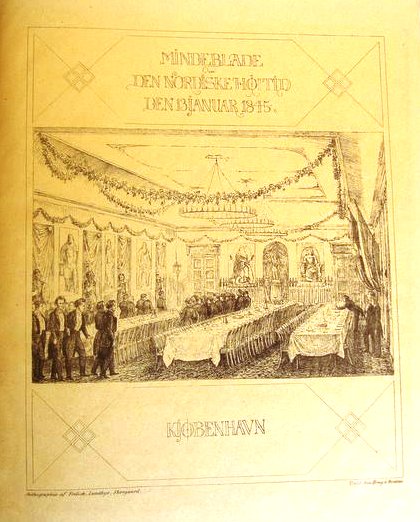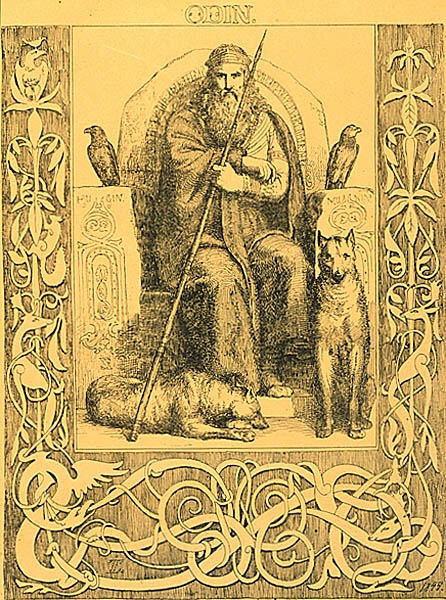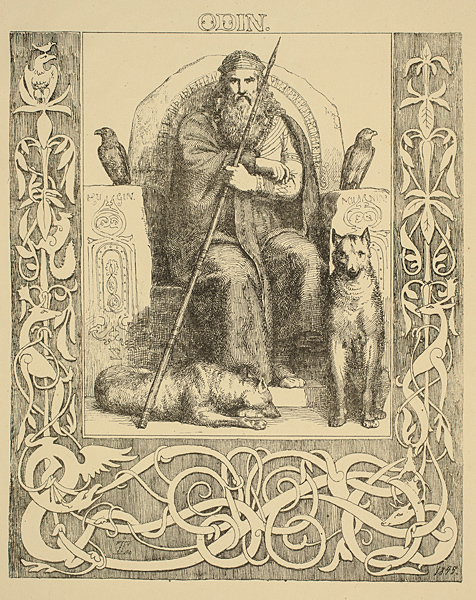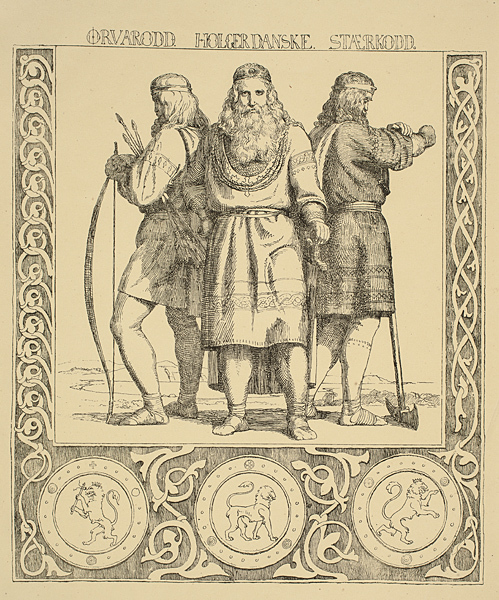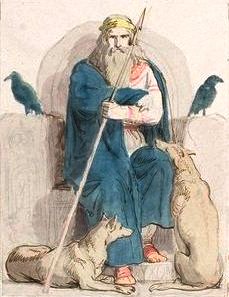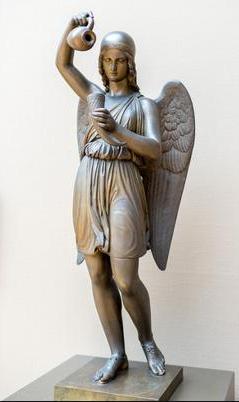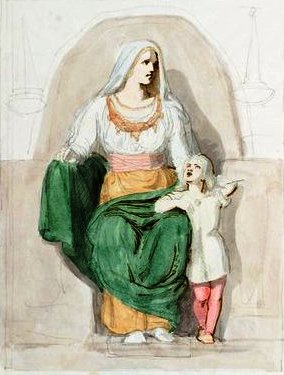1845
Den Nye Studenterforenings Nordiske Højtid
"The New Student Association's Nordic Festival"
Copenhagen, Denmark
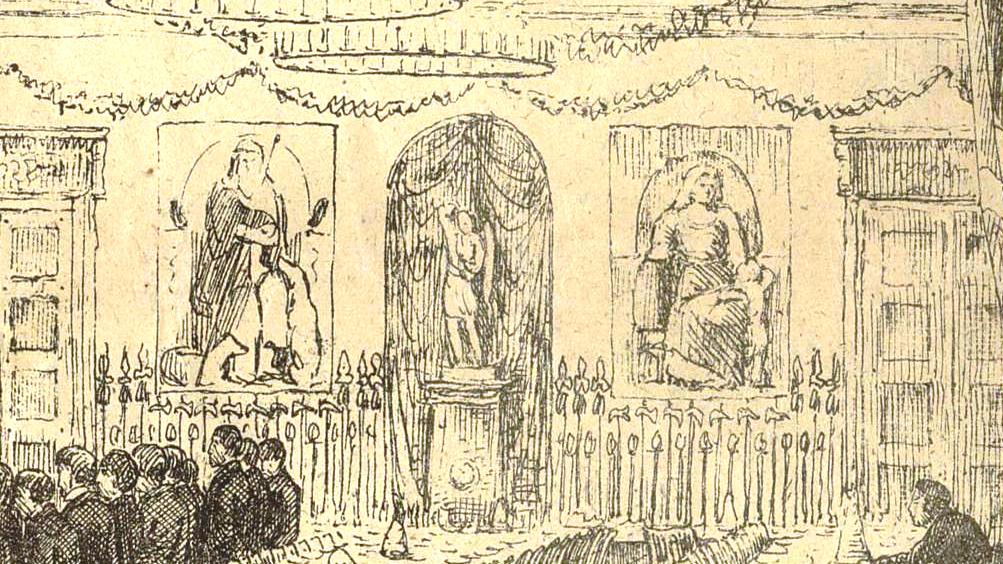
Wall-Banners of the Norse Gods Seated for
the Feast by
Johan Thomas Lundbye
(1818-1848)
Peter
Christian Thamsen Skovgaard
(1814-1875)
and Lorenz Frølich
(1820-1908)
Published in Mindeblade om den Nordiske Høitid
Souvenir
Book of the Nordic Festival,
13 January 1845
An Autograhie of Frølich, Lundbye and Skovgaard
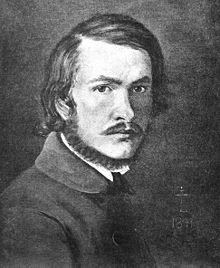
J. Th. Lundbye
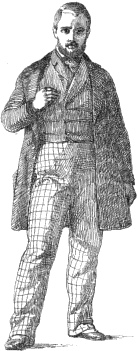
J. Th. Lundbye
Self-Portrait 1836 |
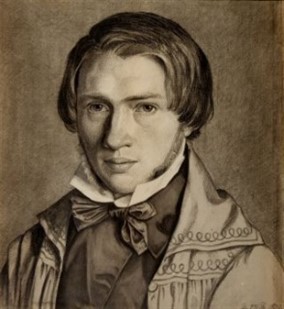
P.C. Skovgaard
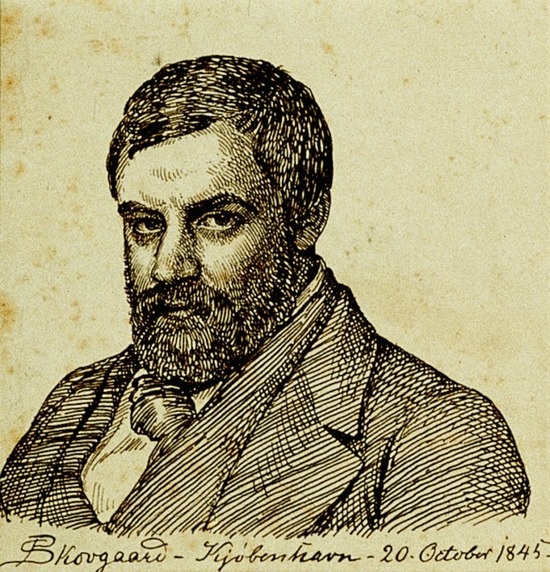
Lorenz Frølich
drawn by P.C. Skovgaard 1845 |
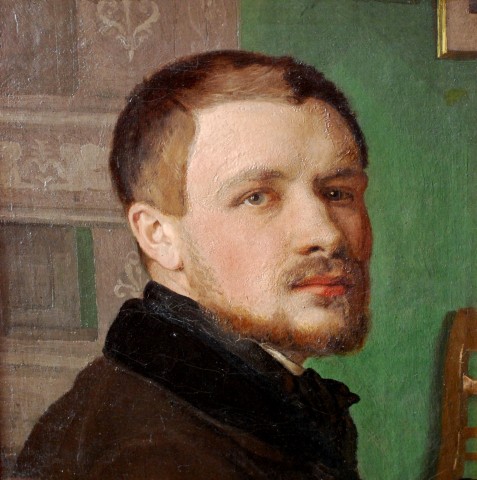
Lorenz Frølich
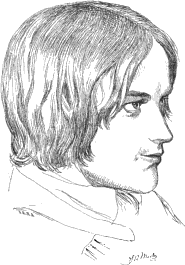
Lorens Frølich
drawn by J. Th. Lundbye, 1838
|
|
FRIENDS AND FELLOW ARTISTS |
In the summer of 1836, Lorenz Frølich in the company of
his father made a trip to Holland to study Art.
Høyen,
who had had the great pleasure to show him paintings in
Haarlem and Amsterdam, referred to him as an utterly
enchanting young man, "who promises to be something of an
artist." At that time,
Frølich was already a promising young artist. His
youthful drawings of leaping horses and other animals are
admirable. In 1838, he made his debut at the exhibition with
four pictures of animals —the same year he won Johan Thomas
Lundbye's faithful friendship. Both were genuine nature
artists, both dreamers and enthusiasts of the Icelandic
sagas, for Grundtvig, for poetry, for antiquity and the
Middle Ages.
Lundbye spent his happiest hours in Frølich's Company. He
was much more influenced by Frølich than Frølich was
influenced by him. It is probably Frølich, who first
experimented with the decorative intertwined animals with
which Lundbye, who also had an excellent sense of the purely
decorative, so often framed his drawings. In 1840,
Frølich travelled to Germany, where he underwent training,
first in Munich and later in Dresden. He found German Art
more akin to his own style than the Arts which reigned in
Denmark.
In late summer 1844 Frølich returned home to the great
delight of Lundbye. Arm in arm they walked, as they took
long tours on foot to Grundtvig Lectures, also to see
Grundtvig himself, and on the 13th of January
1845 —the last day of Christmas and the momentous day when
the light came back to the North— for the great "Nordic
feast" held by the Student Association which was
simultaneously celebrated in Christiania, Upsala and Lund.
"Skovgaard, Frølich and I", Lundbye says in his diary, "did
take upon ourselves to decorate the Rifleman’s Hall with
pictures of the Nordic gods, which, with the exception of
Loki, were all composed by Frølich. Loki was executed by
Skovgaard, from his own concept of him. It was a merry
effort; we started on Thursday the 11th and had
finished by Sunday evening with 11 large cartoons of the
gods in supernatural size, all seated; Frølich happily
drafted and finished their heads, and when he had worked
himself to exhaustion, took a different tone, with song and
merriment flowing cheerfully from him."
"The Norse gods were chosen as motifs for Skovgaard's,
Lundbye's and Lorenz Frølich's collective decoration
of the banqueting hall of the Rifle Range on the occassion
of the Scandinavian Students' Conference on 13 January 1845.
Frølich was presumably the driving force behind the
decoration, while Skovgaard made his original contribution
with Loki, who differs from the other gods by departing from
the strictly frontal representation and motion of the
figure. Among the gods of the North, large Danish flags were
hung."
The Danish part of the celebration
was organized by the Student Association and took place
in the building of the Royal Shooting Society,
Copenhagen’s current City Museum since 1956. The
decorations emphasized the solemn nature of the event.
Frølich, Lundbye and Skovgaard had made chalk drawings
of the Aesir gods in great size. The drawings were
surrounded by pine garlands that hung down the walls. In
the chamber's upper end shone Bissen’s white Valkyrie
leaning forward from a grand cavern and a lower niche
was covered with a large image representing Starkodder,
Orvar Odd and Holger the Dane back to back. Over the
tables waved the Nordic flag. The painted portion of
this holistic décor was the ten depictions of Norse
gods. None of them is preserved, but the characters were
drawn on lithographic paper and later published in a
monumental book. Skovgaard is considered to be the
artist of Loki, while Lundbye designed all of the frames
and the Heimdal figure. Yet according to P. Johansen:
"Lundbye did the characters Odin, Frigga, Freyr, Freya,
Brage, Ydun, Heimdall, Ørvarodd, Holger the Dane and
Stærkodd; Frølich has drawn Thor, Balder and Loki "(!!).
|
|
Their original illustrations are lost, but
the artists reproduced them in the pages of a commemorative prints
titled Mindeblade om den nordiske Høitid 13. Januar 1845
("Souvenir-book of the Nordic Festival. 13 January 1845"), a big and beautiful Autograph
printed by Bing and Ferslew, Copenhagen in folio format with a
lithographed cover and a total of 11 lithographed plates with
reproductions of Norse gods, created to commemorate
the Den Nye Studenterforenings Nordiske Højtid ("The New Student
Association's Nordic Festival"). This memorial
is the only visible remains of the great solemnity of the Student
Association, which in 1845 marked the high point of Danish Student
Scandinavianism.
The illustration on the cover
depicts the banqueting hall with the images hung as described above. The 12
prints, 11 of which are of Norse gods, are listed as:
| |
"SKYDEBANENS STORE SAL" (The Rifle Range's
Great Hall)
"ODIN"
"FRIGGA and GERSIMI"
"THOR"
"BALDER"
"FREIR"
"FREIA"
"BRAGE"
"YDUN"
"HEIMDAL"
"LOKE"
"ØRVAR-ODD. HOLGER
THE DANE.
STÆRKODD."
|
|
| |
|
|
| |

The Rifle
Range's Great Hall decorated for the feast.
Portraits of Odin and Frigg flank
H.W. Bissen's Valkyrie
in central niche.
|
|
Freyr, Idunn and Thor can be identified in the banners to the
left.
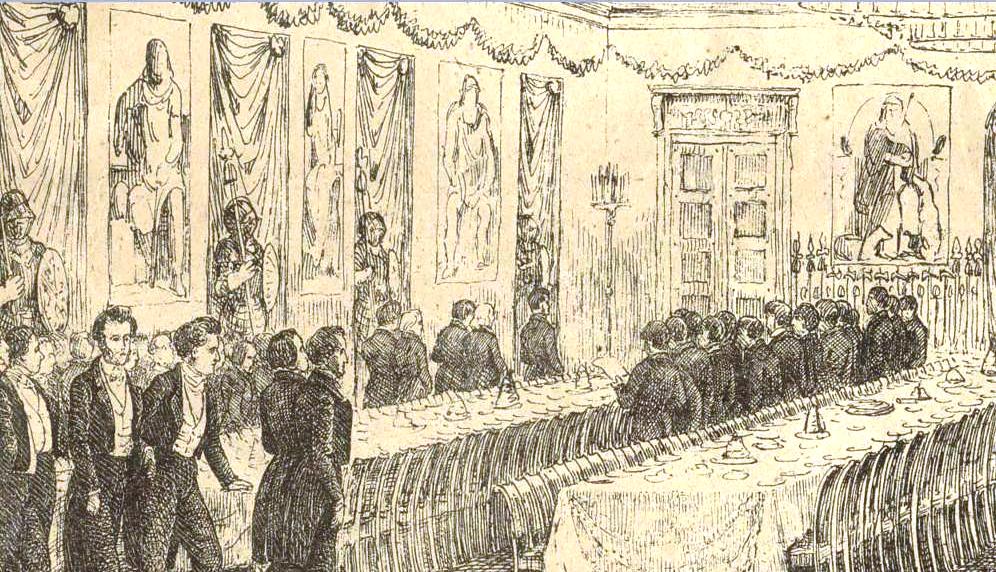
LIFE-SIZE
WALL HANGINGS
Norse Gods Seated for the
Feast
Surviving Sketches
|
|
|
|
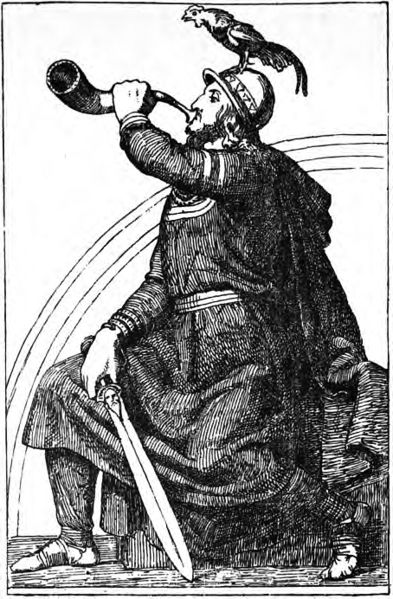
Heimdall by J. Th. Lundbye
(1837) |
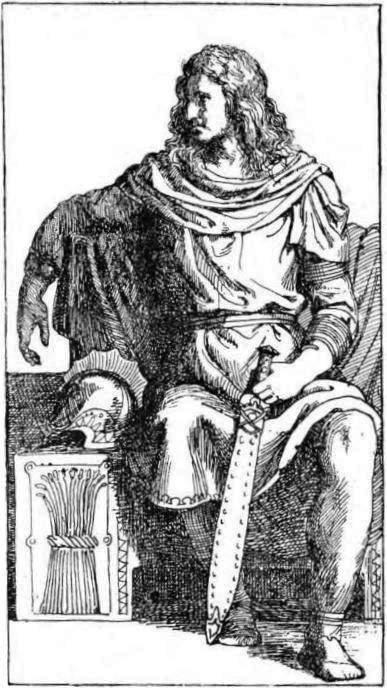
Freyr by J. Th. Lundbye
(1837) |
|
|
|
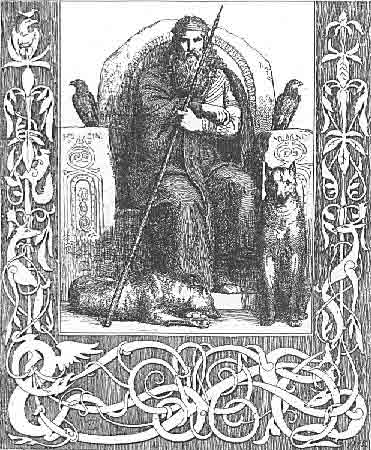
Odin by Lorenz Frølich
|
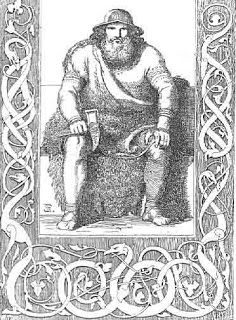
Thor by Lorenz Frølich
|
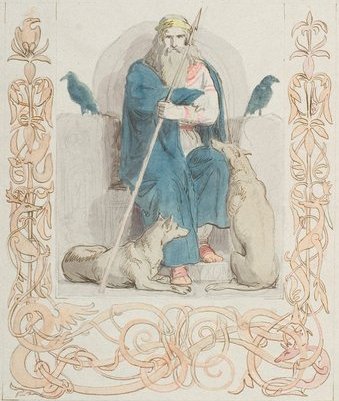 |
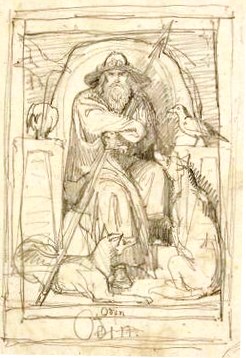 |
Design sketches of Odin showing the development of the finished
illustration (above, left)
|
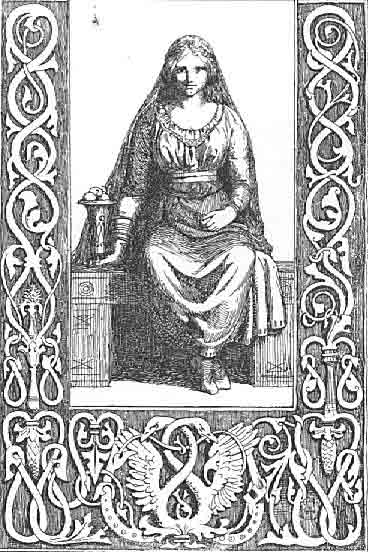
Idun by Lorenz Frølich |
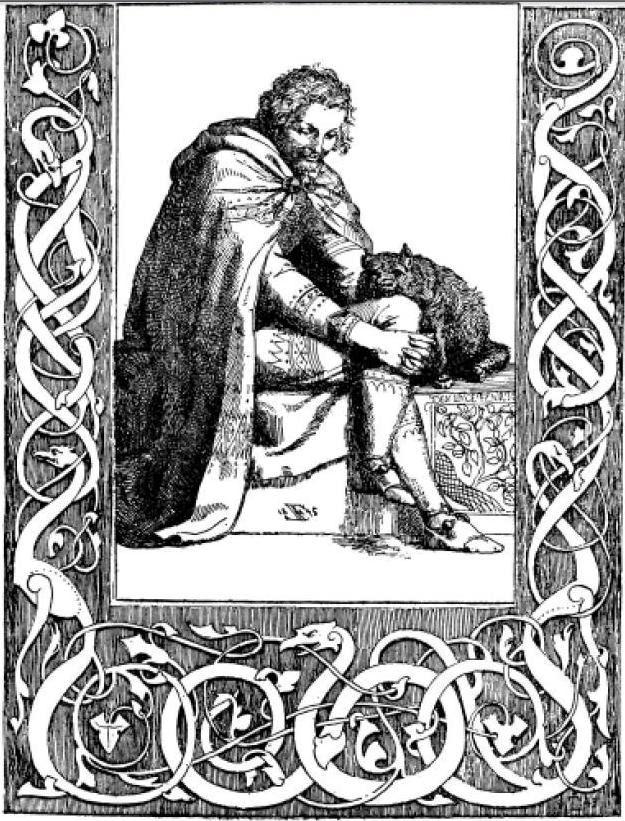
Loki by P.C. Skovgaard |
The following are
miscellaneous
design sketches by
Lorenz Frølich, which appear to
be
part of this collection, held by the
National Gallery of Denmark (Statens
Museum Kunst and
SMK).
|
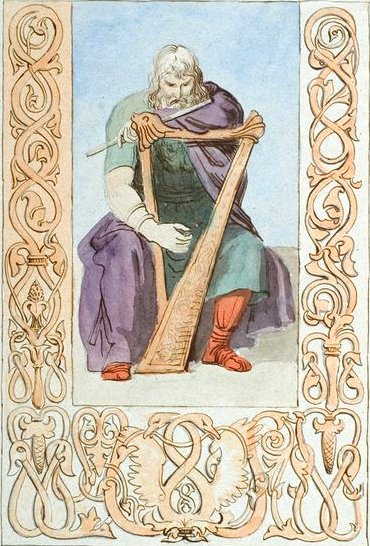
Bragi
|
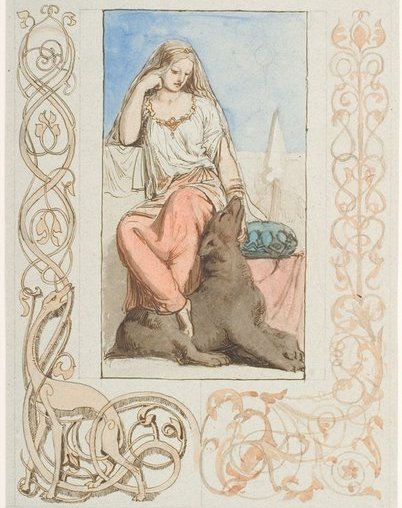
Freyja with bear |
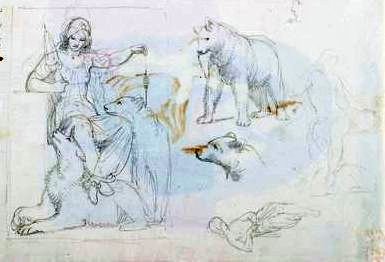
Sketch of Freyja with
bears
based on the then-contemporary debate
regarding "Freyja's
fressa"
(cats or bears) |
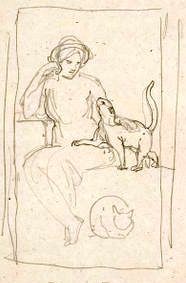
Sketch of Freyja with cat |
| |
|
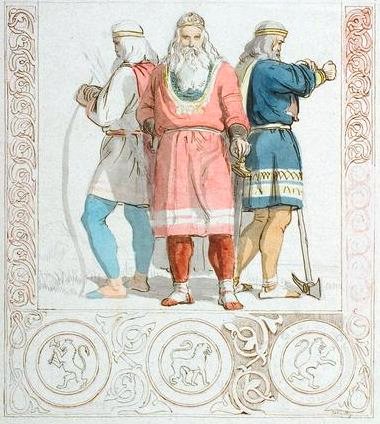
Arrow-Odd, Holger the Dane, and
Stærkodd
|
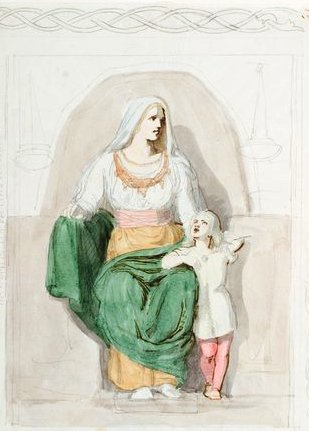
Frigg and Gersemi (Freyja's daughter)
The spindle was depicted with 3 stars
as in the constellation Friggjar rök (Orion's Belt) |
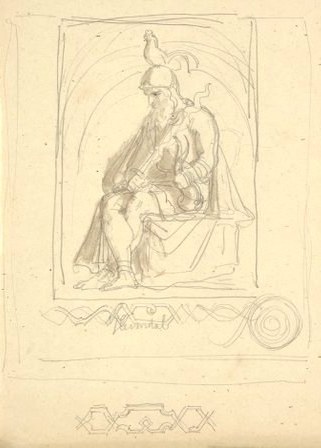
Sketch for Heimdal
by Lorenz Frølich |
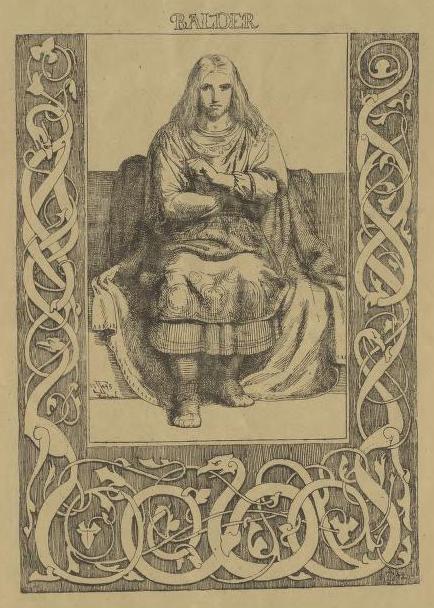
Balder
by Lorenz Frølich |
|
|
In 1845, the young archeologist Jens Jacob Asmussen Worsaae
delivered the opening speech at the great “Nordic Festival for the
Commemoration of the Ancestral Fathers”, at which the National
Liberal elite assembled for the purpose of promoting the idea of a
united North. The scene was elaborately set with suitably “Nordic”
decorations completed in just four days by the young artists Lorenz
Frölich, Johan Thomas Lundbye and Peter Christian Skovgaard. Eleven
huge, neo- Nordic representations of the gods adorned the walls and
were a tremendous success, so much so that they were later published
as a special edition booklet that was to gain wide circulation.
N.F.S. Grundtvig was present, and the speakers drank tirelessly in
turn from the so-called Bragisbæger, a silver drinking horn
specially made for the occasion. The feast is remembered
fondly:
"There were candlesticks and good food on the tables, singalongs at
dinner, giant wall decorations and special guests like pastor and
hymn writer N.F.S. Grundtvig, who is also deeply interested in
common Nordic history and Nordic culture. According to the
newspaper, The Fatherland, the speeches were good, and undoubtedly
the food and beer were excellent, but what made the event noteworthy
was the decoration. At this party, a popular visual resentation of
the Nordic Viking was quite literally created. Three young
painters, Lorenz Frolich, P.C. Skovgaard and J.Th. Lundbye, were in
charge of the decoration, which consisted of a number of meters tall
cartoons, depicting gods and heroes from Nordic pre-history. The
heroes Ørva-odd, Holger the Dane, and Stærkodd stood side-by-side in
one of the cartons. They were armed with bow and arrow, sword and
ax, and portrayed with fixed eyes and authoritative expressions. The
other ten cartons showed Norse gods. The figures on the cartons were
completely different than the type we are used to seeing. They are
not overtly graceful or elegant and were far from the ancient ideal
man, as visual art has previously portrayed them. These new heroes
have power, a steely gaze and a touch of the rural. One no longer
sees supple and elegant gods and heroes, but rather strong, robust
and determined figures, who look like the hardworking Zealand
fisherman or Jutland peasant. It is the dawn of the Nordic brand."
Frölich’s many illustrations of historical and archaeological works
were to make an indelible mark on how the North was perceived and
Lundbye's renderings of the zoomorphic ornamentation of the Viking
Age was to inspire the so-called dragon style that was to gain
popularity in the latter half of the 19th century.
Examples of this style can be studied in the buildings around
Holmenkollen in Oslo. Another expression of Nordic movement was the
establishment at the University of Copenhagen in 1845 of a
professorial chair in Old Norse language and mythology and the first
Danish steam locomotive in 1846 being named Odin.
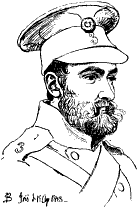
J. Th.
Lundbye
by P.C. Skovgaard, 1848.
|
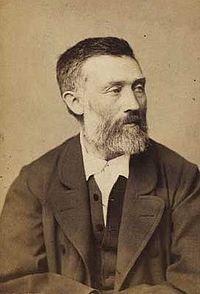
P.C. Skovgaard
Later in Life |
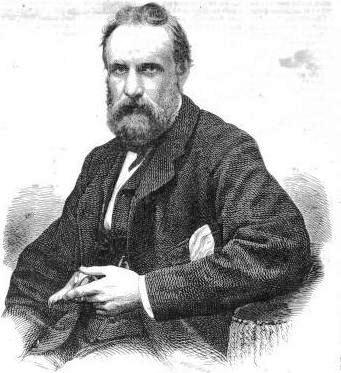
Lorenz Frølich
Later in Life |
P.C. Skovgaard went on to become a famous painter of landscapes,
while
Lorenz Frølich went on to produce a prolific portfolio of Norse
related art. In the early spring of 1848, Th. Lundbye volunteered to
serve in the military, he died in battle later that year.
|
|







